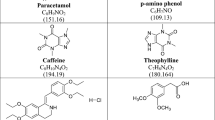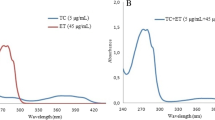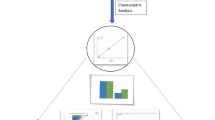Abstract
The CARISOMA™ consists of carisoprodol (CAR), paracetamol (PCM) and caffeine (CAF) used for fibromyalgia and osteoarthritis. The study discussed the comparative study of UV chemometrics (method A), ratio spectra derivative (method B) and HPLC-QbD (method C) for simultaneous estimation of the aforementioned drugs in API and marketed tablet formulation. From the listed methods, method A can estimate CAR without derivatization. Analytical figures of merit (FOM) were determined for method A. The CAR has a weak chromophoric group so diazotization was carried out and the derivatized-CAR (D-CAR) was evaluated by IR, mass and NMR; further estimated by method B simultaneously with PCM and CAF. Method C involved the application of quality by design approach for the estimation of aforesaid drugs. The calibration curves of CAR, PCM and CAF found linear in the range of 1–5 µg mL−1, 2–10 µg mL−1 and 0.2–1 µg mL−1 for method A; 1–5 µg mL−1, 2–10 µg mL−1, 0.2–1 µg mL−1 for method B and 10–50 µg mL−1, 20–100 µg mL−1 and 1.85–9.25 µg mL−1 for method C. Method C involved the use of C18 column and ACN: potassium dihydrogen phosphate buffer (90:10 v/v) as the mobile phase at pH 3. For resolution of drugs, the described methods were successfully applied, validated and compared statistically. Method A was found to be more acceptable due to its accuracy and simplicity.






Similar content being viewed by others
Data availability
The datasets generated during and/or analyzed during the current study are available from the author on reasonable request.
Code availability
Not applicable.
Change history
01 February 2021
A Correction to this paper has been published: https://doi.org/10.1007/s10337-021-04012-3
Abbreviations
- ANOVA:
-
Analysis of variance
- CAR:
-
Carisoprodol
- CAF:
-
Caffeine
- D-CAR:
-
Derivatized carisoprodol
- FFD:
-
Full factorial design
- FOM:
-
Figure of merit
- NPLS:
-
N-Way partial least square
- PCM:
-
Paracetamol
- PCR:
-
Principal component regression
- PLS:
-
Partial least square
- QbD:
-
Quality by design
- RMSEC:
-
Root mean square error of calibration
- RMSECV:
-
Root means square error of cross-validation
- RMSEP:
-
Root mean square error of prediction
References
American Pharmaceutical Association (2012) U.S Pharmacopoeia. American Pharmaceutical Association, Washington
Ministry of health and family welfare (2010) Indian Pharmacopoeia commision. Government of India, New Delhi
Sweetman S, Martindale W (2007) Martindale: the complete drug reference, 36th edn. Pharmaceutical Press, London
Sreenivasulu V, Ramesh M, Kumar IJ et al (2013) Simultaneous determination of carisoprodol and aspirin in human plasma using liquid chromatography-tandem mass spectrometry in polarity switch mode: application to a human pharmacokinetic study. Biomed Chromatogr 27:179–185. https://doi.org/10.1002/bmc.2766
Skinner W, McKemie D, Stanley S (2004) Quantitative determination of carisoprodol and its metabolites in equine urine and serum by liquid chromatography-tandem mass spectrometry. Chromatographia 59:S61–S67. https://doi.org/10.1365/s10337-004-0244-6
Delavenne X, Gay-Montchamp JP, Basset T (2011) HPLC MS/MS method for quantification of meprobamate in human plasma: application to 24/7 clinical toxicology. J Chromatogr B Anal Technol Biomed Life Sci 879:215–218. https://doi.org/10.1016/j.jchromb.2010.11.034
Miksa IR, Poppenga RH Direct and rapid determination of baclofen (Lioresal) and carisoprodol (Soma) in bovine serum by liquid chromatography-mass spectrometry. J Anal Toxicol 27:275–83. https://doi.org/https://doi.org/10.1093/jat/27.5.275
Rohith T, Ananda S, Gowda N (2013) Method development and validation of carisoprodol and its impurities by ultra violet-high performance liquid chromatography. Adv Anal Chem 3:15–19. https://doi.org/10.5923/j.aac.20130302.02
Fisher J, Sherma J (2001) Analysis of carisoprodol tablets by HPTLC with visible absorbance densitometry. Acta Chromatogr 11:96–101
Hadad GM, Abdel-Salam RA, Emara S (2012) Determination of glucosamine and carisoprodol in pharmaceutical formulations by LC with pre-column derivatization and UV detection. J Chromatogr Sci 50:307–315. https://doi.org/10.1093/chromsci/bms008
Shihana F, Dissanayake D, Dargan P, Dawson A (2010) A modified low-cost colorimetric method for paracetamol (acetaminophen) measurement in plasma. Clin Toxicol 48:42–46. https://doi.org/10.3109/15563650903443137
Matsumoto T, Sano T, Matsuoka T et al (2003) Simultaneous determination of carisoprodol and acetaminophen in an attempted suicide by liquid chromatography-mass spectrometry with positive electrospray ionization. J Anal Toxicol 27:118–122. https://doi.org/10.1093/jat/27.2.118
Pawar VT, Pishawikar SA, More HN (2011) Spectrophotometric estimation of aceclofenac and paracetamol from tablet dosage form. Int Res J Pharm 2:93–98
Murtaza G, Khan A, Shabbir A et al (2011) Development of a UV-spectrophotometric method for the simultaneous determination of aspirin and paracetamol in tablets. Sci Res Essays 6:417–421. https://doi.org/10.5897/SRE10.925
Islam SMA, Shultana S, Bin SMS, Dewan I (2012) UV-Spectrophotometric and RP-HPLC methods for the simultaneous estimation of acetaminophen and caffeine: validation, comparison and application for marketed tablet analysis. Int J Pharm 2:39–45
An DTT, Hoang VD (2009) Simultaneous determination of paracetamol and codeine phosphate in combined tablets by first-order derivative and ratio spectra first-order derivative UV spectrophotometry. Asian J reserch Chem 2:143–147
Sawant R, Bhangale L, Joshi R, Lanke P (2010) Validated spectrophotometric methods for simultaneous estimation of paracetamol, domperidone and tramadol HCl in pure and tablet dosage form. J Chem Metrol 4:21–27
Wang A, Sun J, Feng H et al (2008) Simultaneous determination of paracetamol and caffeine in human plasma by LC-ESI-MS. Chromatographia 67:281–285. https://doi.org/10.1365/s10337-007-0493-2
Khanage SG, Mohite PB, Dharam PG, Deshmukh VK (2015) Development and validation of reversed phase high performance liquid chromatographic method for simultaneous estimation of paracetamol, caffeine and carisoprodol in tablet formulation. Eurasian J Anal Chem 10:163–179
Patel M, Shah C (2018) Multivariate UV-chemometric and HPLC-QbD method for simultaneous estimation of vardenafil and dapoxetine in active pharmaceutical ingredients and its marketed formulation. Curr Anal Chem. https://doi.org/10.2174/1573411014666180501122512
Patel MN, Kothari CS (2016) Multivariate approaches for simultaneous determination of avanafil and dapoxetine by UV chemometrics and HPLC-QbD in binary mixtures and pharmaceutical product. J AOAC Int. https://doi.org/10.5740/jaoacint.15-0259
Patel MN, Kothari CS (2018) Review on implementation of multivariate approach for forced degradation study and impurity profiling with regulatory considerations. Chromatographia. https://doi.org/10.1007/s10337-017-3393-0
Olivieri AC, Faber NM, Ferré J et al (2006) Uncertainty estimation and figures of merit for multivariate calibration (IUPAC Technical Report). Pure Appl Chem 78:633–661. https://doi.org/10.1351/pac200678030633
Biancolillo A, Marini F (2018) Chemometric methods for spectroscopy-based pharmaceutical analysis. Front Chem 6:576. https://doi.org/10.3389/fchem.2018.00576
Gummadi S, Chandaka PK (2019a) Chemometrics approach to drug analysis. An overview. Am J PharmTech Res 9:1–13. https://doi.org/10.46624/ajptr.2019.v9.i1.001
Gummadi S, Chandaka P (2019b) Chemometrics approach to drug analysis—an overview. Am J PharmTech Res 9:1–13. https://doi.org/10.4624/ajptr.2019.v9.i1.001
Patel NS, Nandurbarkar VP, Patel AJ, Patel SG (2014) Simultaneous spectrophotometric determination of celecoxib and Diacerein in bulk and capsule by absorption correction method and chemometric methods. Spectrochim Acta Part A Mol Biomol Spectrosc 125:46–52. https://doi.org/10.1016/j.saa.2014.01.036
Tena RC, Delgado MA, Sanchez M, Montelongo FG (1997) Comparative study of the zero-crossing, ratio spectra derivative and partial least-squares methods applied to the simultaneous determination of atrazine and its degradation product desethylatrazin-2-hydroxy in ground waters. Talanta 44:673–683. https://doi.org/10.1016/s0039-9140(96)02104-2
El-Yazbi FA, Hammud HH, Assi SA (2007) Derivative-ratio spectrophotometric method for the determination of ternary mixture of aspirin, paracetamol and salicylic acid. Spectrochim Acta Part A Mol Biomol Spectrosc 68:275–278. https://doi.org/10.1016/j.saa.2006.11.027
Khamanga SM, Walker RB (2011) The use of experimental design in the development of an HPLC-ECD method for the analysis of captopril. Talanta 83:1037–1049. https://doi.org/10.1016/j.talanta.2010.11.025
Rote AR, Bari PD (2009) Ratio spectra derivative and zero-crossing difference spectrophotometric determination of olmesartan medoxomil and hydrochlorothiazide in combined pharmaceutical dosage form. AAPS PharmSciTech 10:1200–1205. https://doi.org/10.1208/s12249-009-9318-y
Krishna MV, Dash RN, Jalachandra Reddy B et al (2016) Quality by Design (QbD) approach to develop HPLC method for eberconazole nitrate: application oxidative and photolytic degradation kinetics. J Saudi Chem Soc 20:S313–S322. https://doi.org/10.1016/j.jscs.2012.12.001
Luo YR, Han J, Yun C, Lynch KL (2019) Azo coupling-based derivatization method for high-sensitivity liquid chromatography–tandem mass spectrometry analysis of tetrahydrocannabinol and other aromatic compounds. J Chromatogr A 1597:109–118. https://doi.org/10.1016/j.chroma.2019.03.022
ICH tripartite guideline (2005) Validation of analytical methods: definitions and terminology Q2(R1). https://www.ich.org/page/quality-guidelines. Accessed 20 Sep 2020
Acknowledgements
The authors express their sincere thanks to Centurion Pharmaceutical Pvt. Ltd., India and Cadila Healthcare Pvt. Ltd., India for supplying gift samples of pure Carisoprodol (CAR), Paracetamol (PCM) and Caffeine (CAF).
Funding
Not applicable.
Author information
Authors and Affiliations
Contributions
All authors have contributed to the final manuscript.
Corresponding author
Ethics declarations
Conflict of interest
All the authors report no conflict of interest. The authors alone are responsible for the content and writing of this article.
Additional information
Publisher's Note
Springer Nature remains neutral with regard to jurisdictional claims in published maps and institutional affiliations.
Electronic supplementary material
Below is the link to the electronic supplementary material.
Rights and permissions
About this article
Cite this article
Patel, M.N., Patel, A.J., Shah, U.H. et al. Comparative Study of the UV Chemometrics, Ratio Spectra Derivative and HPLC-QbD Methods for the Estimation of Their Simultaneous Estimation in Combined Marketed Formulation. Chromatographia 84, 75–86 (2021). https://doi.org/10.1007/s10337-020-03979-9
Received:
Revised:
Accepted:
Published:
Issue Date:
DOI: https://doi.org/10.1007/s10337-020-03979-9




